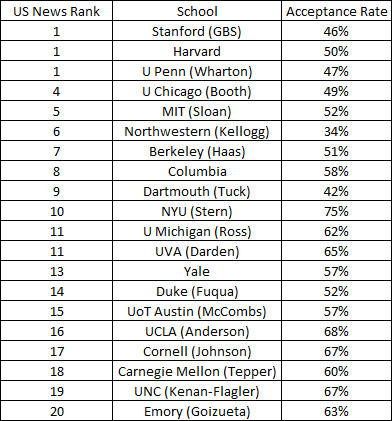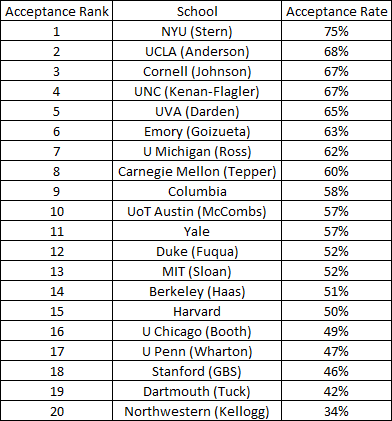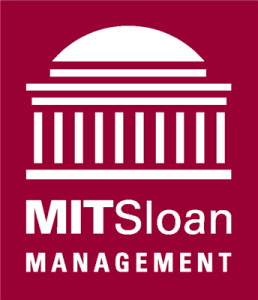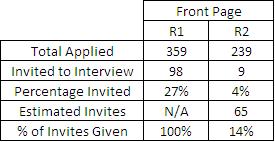Many applicants may wonder if their undergraduate major impacts their chance of getting into business school. Admissions data suggests that your college major can significantly impact your probability of getting into business school. The general trend seems to be that majors that are more dominated by women have a higher acceptance rate while industries that dominated by men had lower acceptance rates. This could be because my data does not have gender as a variable, so I could not account for it. Many people believe that women’s acceptance rate is higher than it is for men with similar credentials, but I have not found any data that proves it. Another explanation is that the female dominated majors are generally underrepresented in business school application pools, so when schools aim to diversify the class, the acceptance rates are higher for those majors. Continue reading
Tag Archives: Sloan
MBA Waitlist Acceptance Rate Analysis (with Class of 2019 data)
 One of the most frustrating parts of the MBA application process is waiting to hear back from the schools. First, applicants have to wait to hear if you will be interviewed. Next, an applicant must wait to hear if they have been admitted. Some unlucky souls will have to wait a third time on the waitlist, sometimes for up to 8 months if they are a round 1 applicant. I created this updated MBA waitlist acceptance rate analysis to provide some transparency to those who are on the waitlist. Continue reading
One of the most frustrating parts of the MBA application process is waiting to hear back from the schools. First, applicants have to wait to hear if you will be interviewed. Next, an applicant must wait to hear if they have been admitted. Some unlucky souls will have to wait a third time on the waitlist, sometimes for up to 8 months if they are a round 1 applicant. I created this updated MBA waitlist acceptance rate analysis to provide some transparency to those who are on the waitlist. Continue reading
MBA Interview Probability for top schools by GMAT and GPA
With round 2 application deadlines rapidly approaching, many applicants may wonder what their chance of getting an MBA interview with their favorite schools is. I analyzed the MBA interview probability for the top 25 schools over the past 5 years by GMAT and GPA. Unsurprisingly, for most schools the MBA interview chance increased for high GMAT and high GPA candidates. Continue reading
Military MBA Acceptance Rate Analysis
 Transitioning from the military to MBA is a fairly popular path to follow. A little over 4% of MBA applications come from military veterans. When looking at the data comparing military applicants to traditional MBA applicants, a few trends become clear:
Transitioning from the military to MBA is a fairly popular path to follow. A little over 4% of MBA applications come from military veterans. When looking at the data comparing military applicants to traditional MBA applicants, a few trends become clear:
- Military / Veteran applicants tend to be a year or two older.
- Scores for military applicants are a little lower on average, about 15 points on the GMAT and about .15 for GPA
- Military applicants on average have another year or two of work experience
- Military MBA acceptance rate is about 50% higher than the acceptance rate for traditional applicants
- Some schools have a very large advantage for military applicants while others have little to no advantage
Best Schools for Young MBA Applicants
Deciding when to start applying to business school can be a challenge. Salary increases dramatically after an MBA, but schools tend to prefer applicants with more work experience. I looked at the top 25 US MBA programs’ admission data to find the best schools for young MBA applicants in terms of chance of being admitted. I analyzed the MBA acceptance rate by age to see which schools had the smallest disadvantage for younger applicants relative to traditionally aged MBA applicants. Continue reading
Updated MBA Acceptance Rate by Round
The third round of MBA applications is notorious for having a lower acceptance rate. With the third round application deadlines approaching quickly for most business schools, you may be wondering if the stereotype about the third round is fact or fiction. I updated my analysis of MBA acceptance rate by round with the last 2 years of data and I expanded it to include Olin, Georgetown, USC, Arizona State and Vanderbilt.
This analysis was done using self-reported data from GMAT Club. Data from the class of 2014 through the class of 2018 was used because otherwise there would not be enough data for round 3 and 4 to accurately capture the acceptance rate. Continue reading
MBA Round 3 Application Deadline
It is mid March and the application season for the class of 2019 is winding down. If you plan to apply for this year, you should check the MBA Round 3 Application Deadline for the school of your dreams because it is fast approaching or already past. Also, check out the MBA acceptance rate for round 3 at the schools you are considering. Continue reading
McKinsey Emerging Scholars
For all of you soon to be MBA Students interested in consulting, McKinsey has a great opportunity for you. Apply for the McKinsey Emerging Scholars program by May 19th 2016. If you are selected to be a scholar, then you will receive a monetary award, mentorship from McKinsey consultants and an invitation to a celebratory event. Continue reading
Optimal MBA Application Number
Many business school applicants wonder how many MBA applications they should submit? In this article, I will discuss the optimal MBA application number based on real data. Deciding on your MBA application number is challenging because the more schools you apply to, the less time you have to spend on each application. On the other hand, you don’t want to put all of your eggs into one or two baskets. The data suggests that the ideal number of MBA applications is 5 to 7. For more information, check out this article on how to build your portfolio of MBA applications co-authored by Lawrence Linker and I. Continue reading
MBA Interview Acceptance Rate by GMAT and GPA
The interview is a crucial component of the MBA admission process. All top full-time MBA programs interview applicants before admitting them. Generally the MBA admissions committee is looking for two things during the interview, that you fit the culture of the school and that you have the emotional intelligence to succeed at business school. I have already looked at MBA Interview acceptance rate by itself. However, I always wondered when applying to business school if all applicants are considered equal after they have been invited to interview or does the rest of the application, like the GMAT and GPA, still matter. It turns out that it matters at some schools and not at others. Continue reading
MBA Acceptance Rate by Concentration
With the current semester just about over, next years application essay questions will be posted in the coming weeks for many schools. Round one applicants should start figuring out their story and crafting their essays. The most important essay for most schools is the question: Why get an MBA and why is [insert school name here] the right choice for you? In order to answer this question you need to have a plan for how an MBA is going to help you achieve your goals. The vast majority of MBA students are looking to switch careers. Why else pay $120,000 in tuition and give up two years of salary? If you wanted to stay in the same industry, you would probably just go for a promotion or switch companies. Continue reading
MBA Waitlist Acceptance Rate Rank
A more up-to-date analysis of MBA waitlist acceptance rate has been completed which include admissions data for the class of 2019.
At this point in the year many applicants have been placed on the waitlist for the school of their dreams. It is a frustrating experience that I personally have experienced. This articles shows the MBA waitlist acceptance rates for the top US MBA programs. The data for this analysis comes from GMATClub. These acceptance rates are meant to give a rough idea of the waitlist acceptance rate and should be taken with a grain of salt. The sample sizes vary by school; Olin, Emory and Stanford have the lowest sample sizes.
MBA Waitlist Acceptance Rate by School Rank
| US News Rank | School | Waitlist Acceptance Rate |
|---|---|---|
| 1 | Stanford | 9% |
| 2 | Harvard | 2% |
| 3 | Wharton | 6% |
| 4 | Booth | 15% |
| 5 | Sloan | 8% |
| 6 | Kellogg | 6% |
| 7 | Haas | 4% |
| 8 | Columbia | 6% |
| 9 | Tuck | 10% |
| 10 | Darden | 16% |
| 11 | NYU | 3% |
| 11 | Ross | 11% |
| 13 | Duke | 4% |
| 13 | Yale | 3% |
| 15 | Anderson | 18% |
| 16 | Cornell | 11% |
| 17 | McCombs | 8% |
| 18 | Kenan-Flagler | 46% |
| 19 | Olin | 30% |
| 20 | Tepper | 13% |
| 21 | Emory | 4% |
MBA waitlist acceptance rates ranges widely from 46% to 2% depending on the school. It tends to vary quite a bit from year to year, so these acceptance rates should only be used as a guide. For example Dartmouth’s average waitlist acceptance rate is 10%, however for the class of 2016 it was only 2%. The top ten schools on average have a slightly lower waitlist acceptance rate coming in at 8% while the next ten schools average a noticeably higher acceptance rate of 14%.
MBA Waitlist Acceptance Rate Rank
| Acceptance Rank | School | Waitlist Acceptance Rate |
|---|---|---|
| 1 | Kenan-Flagler | 46% |
| 2 | Olin | 30% |
| 3 | Anderson | 18% |
| 4 | Darden | 16% |
| 5 | Booth | 15% |
| 6 | Tepper | 13% |
| 7 | Ross | 11% |
| 8 | Cornell | 11% |
| 9 | Tuck | 10% |
| 10 | Stanford | 9% |
| 11 | Sloan | 8% |
| 12 | McCombs | 8% |
| 13 | Kellogg | 6% |
| 14 | Wharton | 6% |
| 15 | Columbia | 6% |
| 16 | Emory | 4% |
| 17 | Duke | 4% |
| 18 | Haas | 4% |
| 19 | Yale | 3% |
| 20 | NYU | 3% |
| 21 | Harvard | 2% |
The schools with the highest MBA waitlist acceptance rates are Kenan-Flagler, Olin, and Anderson. At the other end are Harvard, NYU and Yale with the lowest waitlist acceptance rates. Although NYU has the highest interview acceptance rate, it rarely accepts anyone off the waitlist.
MBA Acceptance Rate by Application Round
Some business schools have roughly the same acceptance rate during all rounds while others see a significant drop off in later rounds. With applications for round 3 due in the next month or two, this analysis may help you decide which schools to focus on and which to avoid. Here is a list of the top 20 schools’ MBA acceptance rates by application round. The data for this analysis came from GMAT Club, which may be a biased sample. People on GMAT Club tend to have higher GMAT scores than the general applicant pool, so the acceptance rate can be significantly higher for some schools. The acceptance rates are meant to give you an idea of the relationship between rounds, not the absolute acceptance rate. These numbers are raw and not adjusted for other variables such as GMAT and GPA.
MBA Acceptance Rate by Round
The first table is MBA acceptance rates by round ordered by school ranking. The acceptance rates that have a star next to them means that the sample size is very small and might not be very accurate.
| US News Rank | School | Round 1 | Round 2 | Round 3 | Round 4 |
|---|---|---|---|---|---|
| 1 | Stanford | 8% | 5% | 2% | - |
| 1 | Wharton | 19% | 16% | 0%* | - |
| 1 | Harvard | 12% | 6% | 4% | - |
| 4 | Booth | 29% | 25% | 15% | - |
| 5 | MIT | 16% | 11% | - | - |
| 6 | Kellogg | 26% | 23% | 20%* | - |
| 7 | Haas | 17% | 17% | 6% | |
| 8 | Columbia | 23% | 20% | - | - |
| 9 | Tuck | 28% | 29% | 22% | 9% |
| 10 | NYU | 29% | 27% | 21% | |
| 11 | Ross | 41% | 42% | 38%* | - |
| 11 | Darden | 32% | 33% | 16% | - |
| 13 | Yale | 24% | 27% | 9% | - |
| 14 | Duke | 31% | 33% | 21% | - |
| 15 | McCombs | 38% | 36% | 28% | - |
| 16 | Anderson | 26% | 34% | 9% | - |
| 17 | Johnson | 39% | 36% | 37% | - |
| 18 | Tepper | 24% | 38% | 43% | - |
| 19 | Kenan-Flagler | 36% | 40% | 60% | - |
| 20 | Emory | 26% | 40% | 37% | - |
Schools with Significantly Lower Round 3 Acceptance Rate
Many of the top 20 MBA programs have significantly lower acceptance rates in round 3 to the point where it is better to wait until next year to apply. Harvard, Stanford and Wharton, the number one ranked schools, have a large decrease in acceptance rate for round 3. Only 2% to 3% of applications for these schools are in round 3 because everyone knows that acceptance rates are so low. Haas, Yale, Duke, UVA and UCLA also see a significant drops in round 3 admissions compared to earlier rounds. Dartmouth has a respectable round 3 acceptance rate of 22%, but a very low 9% chance of admission for round 4.
Schools with Similar or Higher Round 3 Acceptance Rate
While many schools have a lower acceptance rate for round 3, there are several schools that don’t have a drop off in response. Ross, Cornell, and Emory all have similar admission odds for the third round, while Tepper and UNC actually have a higher acceptance rate for round 3.
Round 3 MBA Acceptance Rate Ranking
This is the the same table as the first one but ranked by round 3 acceptance rate from highest to lowest. Some schools have a round 4 that I did not include, because the sample size was too small. I combined round 4 applications with round 3 except for Tuck because Dartmouth actually had a large number of round 4 applicants.
| Round 3 Rank | School | Round 1 | Round 2 | Round 3 | Round 4 |
|---|---|---|---|---|---|
| 1 | Kenan-Flagler | 36% | 40% | 60% | - |
| 2 | Tepper | 24% | 38% | 43% | - |
| 3 | Ross | 41% | 42% | 38%* | - |
| 4 | Johnson | 39% | 36% | 37% | - |
| 4 | Emory | 26% | 40% | 37% | - |
| 6 | McCombs | 38% | 36% | 28% | - |
| 7 | Tuck | 28% | 29% | 22% | 9% |
| 8 | NYU | 29% | 27% | 21% | |
| 8 | Duke | 31% | 33% | 21% | - |
| 10 | Kellogg | 26% | 23% | 20%* | - |
| 11 | Darden | 32% | 33% | 16% | - |
| 12 | Booth | 29% | 25% | 15% | - |
| 13 | Yale | 24% | 27% | 9% | - |
| 13 | Anderson | 26% | 34% | 9% | - |
| 15 | Haas | 17% | 17% | 6% | |
| 16 | Harvard | 12% | 6% | 4% | - |
| 17 | Stanford | 8% | 5% | 2% | - |
| 18 | Wharton | 19% | 16% | 0%* | - |
| 19 | MIT | 16% | 11% | - | - |
| 19 | Columbia | 23% | 20% | - | - |
The most surprising number is UNC Kenan-Flagler’s round 3 acceptance rate of 60%, which is significantly higher than that of round 1 and 2. I looked at the GMAT and GPA for each round to see if they would explain the high admissions in round 3, however they were both slightly lower than other rounds. I can’t explain why UNC round 3 acceptance rate is so high, but it is a great school to apply to in the third round.
By request, below is the GMAT, GPA and age for Harvard and Booth by round. Round 3 data does not have a ton of data, so take this with a grain of salt.
| School | Variable | R1 | R2 | R3 |
|---|---|---|---|---|
| Booth | GMAT | 735 | 739 | 728 |
| Booth | GPA | 3.61 | 3.62 | 3.58 |
| Booth | Age | 27 | 28 | 29 |
| Harvard | GMAT | 735 | 728 | 720 |
| Harvard | GPA | 3.61 | 3.57 | 3.54 |
| Harvard | Age | 27 | 27 | 27 |
* Sample size is 30 or fewer applications.
MBA Interview Acceptance Rate Rankings
So you have just been invited to interview at the MBA school of your dreams. Obviously this raises your chance of getting in, but by how much? In general, top ten schools have lower MBA interview acceptance rates while schools ranked 11 to 20 have a higher acceptance rate for applicants who were interviewed.
MBA Interview Acceptance Rate by Rank

Interview acceptance rate for Stanford, Harvard, Wharton, Booth, MIT, Kellogg, Hass, Columbia, Dartmouth, NYU, Ross, Darden, Yale, Duke, McCombs, Anderson, Cornell, Tepper, Kenan-Flagler, Emory
The acceptance rate ranges from 34% to 75% for schools in the top 20. The average MBA interview acceptance rate for the top 10 is 50% and it is 62% for schools ranked 11 to 20.
MBA Interview Acceptance Rate Rankings from Highest to Lowest
 NYU jumps out as the highest acceptance rate by a wide margin. If you have been selected to interview at Stern then you can prepare to open a bottle of champagne because you are probably going to business school. No other school in the top 10 has an interview acceptance rate above 60%.
NYU jumps out as the highest acceptance rate by a wide margin. If you have been selected to interview at Stern then you can prepare to open a bottle of champagne because you are probably going to business school. No other school in the top 10 has an interview acceptance rate above 60%.
On the other end of the spectrum is Kellogg and Tuck with the lowest acceptance rates. These two schools will allow anyone who visits campus to interview, so it is not surprising that they admit significantly fewer applicants who are interviewed. Most of the top 10 schools have an acceptance rate clustered between 46% and 51%.
Duke has the lowest acceptance rate for a school not in the top 10 at 52%. The rest of the schools range from 57% to 68%,
Good luck and don’t forget to prepare for your MBA interviews!
Sloan Interview Preparation Guide

At this point all of the Sloan interview invites have been sent out for this year. Unfortunately, I did not receive an invite from Sloan, but I am happy to say that due to all of my preparation, my Wharton interview went very well. Although the team based discussion is a new interview format, I was able to assume a leadership role without being aggressive or obnoxious about it. Since I had already started preparing for a Sloan interview incase I got an invite, I decided to post the Sloan interview preparation I was working on for myself. I hope this is helpful for those who will be interviewing with sloan over the next few weeks. Sloan interviews can take place on campus, in hub cities or even at the offices of alumni. Most Sloan interviews last 40 to 50 minutes, but some have been as short as 15 minutes. I have listed out the questions found in Clear Admit over the past 2 or 3 years in order from most common to least common. The number to the right indicates how many times it was asked.
Sloan Interview Questions:
- Why MBA? (5)
- Describe a time I had to resolve a conflict. (5)
- Anything new to add to your resume since submitting application? (4)
- Why Sloan? (4)
- What do you me to get across to the admissions committee about you? (3)
- Questions? (3)
- Tell me of a time you received feedback and how did you respond? (3)
- Tell me about a time you helped a colleague who was struggling professionally. (3)
- Tell me of a time when you had to mentor someone. (3)
- Describe a time when one of your ideas was rejected and what you did. (3)
- Why get an MBA now? (2)
- Tell me about a time you had to persuade your colleagues. (2)
- Walk me through your resume. (2)
- Describe a time when you had to rally a team (2)
- Describe a major initiative that you have worked on. (2)
- What would your recent team members say about you, if they were asked what its like to work with you?
- Tell me about a company in your industry that has caught your eye.
- Given your role at your company (work for a startup), what will it be like when you leave?
- Describe a time when you took a big risk.
- Elaborate on your leadership role in your extracurricular activity.
- Why did you change jobs from (company x) to (current company)?
- You have an offer from (current company) to return. Do you intend on taking it?
- Explain what your prior employer does, your contributions there and why you decided to move to your current job.
- Will you return to your employer after graduation?
- Describe a time when you had to say “no” to a boss.
- Tell me about your biggest achievement.
- Did you talk to someone about the Sloan program?
You will be in good shape if you prepare for the 10 to 15 most common questions. It may be helpful to look at the questions that have only been asked once, but I would not spend too much time prepping for them. For more info on preparing for a Sloan interview, check out my MBA interview preparation guide.
Few MIT Interview Invites for Round 2
Similar to many of the applicants on the GMAT Club forum I have been impatiently waiting to hear from Sloan about an interview invite. It seemed to me that the number of invites have been very low so I decided to take a quick look at how low. I put together two charts, one based on the front page statistics and one based off of the table you can download with detailed stats.
For some reason the two sets of numbers do not tie together but they tell the same story. Even though the Sloan interview invite period is more than half over, only 14% of the estimated interview invites have been sent out. My best guess is that the weather has been even worse than normal in Boston this year and has significantly delayed MIT. It is really hard for me to stay positive as the invite deadline quickly approaches, but given the numbers, I think we should all stay positive. It will be interesting to see if Sloan misses the invite deadline for R2 in addition to missing it for R1.
Sloan: How Important is the GMAT vs. GPA
MIT is well known for highly intelligent students who are gifted in math. The rumor is that Sloan cares a lot more about your GMAT score than other schools. Do you think that this is true?
In the graph below you can see that Sloan has a slope of .0057. This means that MIT would consider a 800 GMAT with 3.0 GPA roughly similarly to a 700 GMAT with a 3.57 GPA.
Sloan is tied with Tuck (so far) for the lowest reliance on GMAT score. So far in my analysis Columbia cares the most about GMAT score. Sloans GMAT vs. GPA slope is relatively similar to the other schools, so you should still take the GMAT seriously when applying to Sloan, but clearly it is not the singular most important component of the application.
Methodology: The scatterplot represents the 50% of applicants who are accepted with the lowest GMAT and GPA. It isn’t helpful to look at the top 50% of applicants because those are not the marginal candidates who barely got in. I occasionally will remove very low outliers because those candidates may have been admitted due to very strong connections that most applicants don’t have. I never remove more than 5% of the total accepted students as outliers. The slope of the scatterplot demonstrates the point at which the school is indifferent to GMAT vs. GPA.




